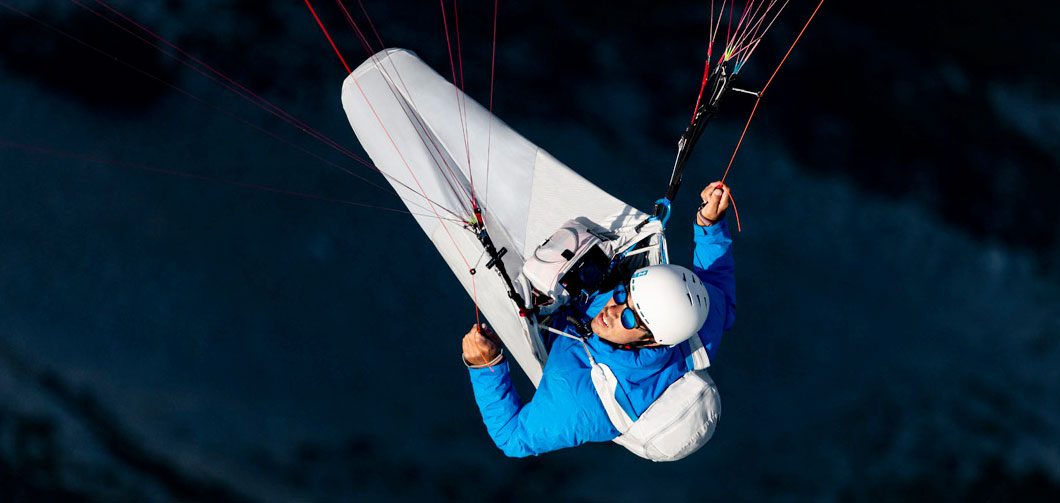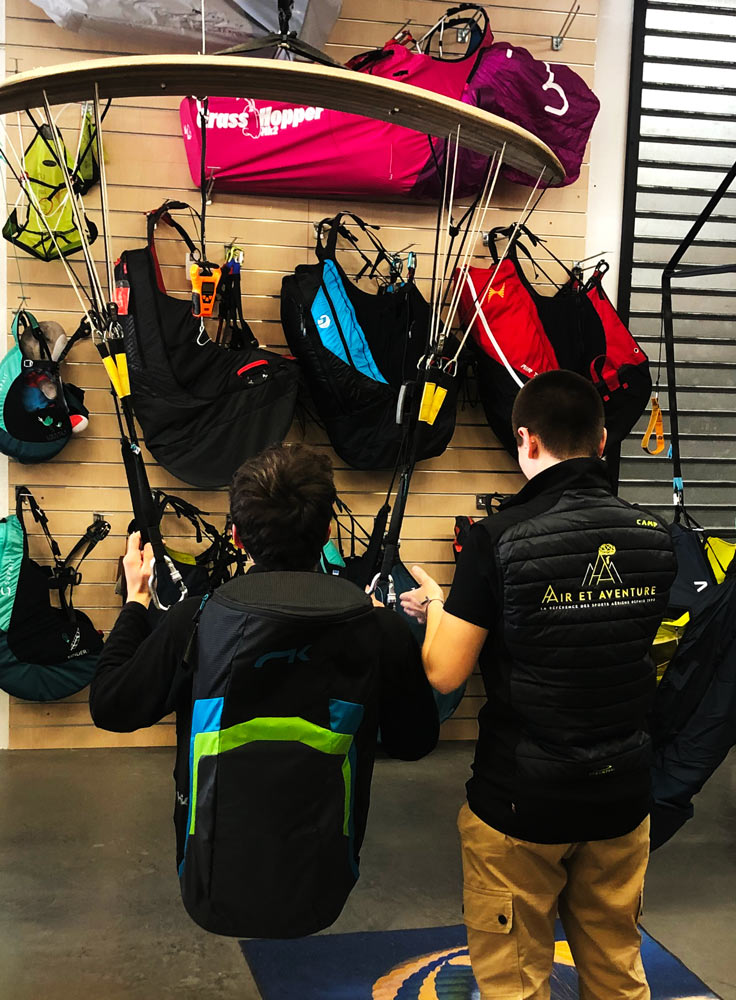Adjusting your paragliding harness : preparing your flying equipment


In paragliding, the harness is the command post during your free flight. If you want to fly in peace and quiet, it's important to be comfortable in the harness, so you can concentrate solely on your flying, and not be disturbed by minor discomforts on take-offs, in the air or on landings.
POSITIONING YOURSELF CORRECTLY IN YOUR PARAGLIDING HARNESS
To sit comfortably in your harness, you need to find the flying position that suits you best. For some pilots, this means sitting with their backs straight. Others prefer to fly in a prone position. It also depends on your type of flying. More supine flights, such as longer cross-country flights, are usually performed in a cocoon. Sitting positions are preferred when flying in string harnesses. Most pilots use a somewhat hybrid sitting/lying posture, allowing them to sit comfortably in their harness while keeping their body compact and enjoying the peaks and beautiful sites.
ADJUSTING THE BACKREST INCLINATION OF YOUR PARAGLIDING HARNESS
Your harness inclination adjustment, located at the ribs/omoplate, is used to control the inclination of your harness. So you can fly more seated or reclined, depending on your preferences.
Consequences of paragliding in a seated position :
In the seated position, you have a better overall view of your surroundings. When you're flying through turbulence, thermals or an incident, you can more easily group your body under the harness for safer, more efficient active piloting. An intermediate to this position is to fly semi-recumbent. This way, you'll still feel secure in your harness, albeit in a slightly more bacqueted position, and you'll still be able to regroup easily if necessary.
Consequences of paragliding in the prone position :
The prone position is more aerodynamic and is generally used in cocoons. However, you may experience some discomfort if you naturally strain your abdominal muscles to pull yourself upright. Here again, if you fly with a cocoon harness, you can of course fly in a relatively seated position. The important thing is that you feel comfortable and secure in your harness throughout your flight.
LUMBAR ADJUSTMENT FOR PARAGLIDING HARNESSES
Not all harnesses have a lumbar adjustment. Its purpose is to fill any gaps that may appear between your lumbar vertebrae and the harness. If this adjustment is incorrectly made, you may quickly feel discomfort or even pain in flight. You may need one or two flights to optimize this adjustment.
Generally speaking, to start with, loosen the adjustment completely, sit in your harness (under a gantry) and, if you can, ask someone to tighten it to the point of contact with your back, or even force it a little. In most cases, you'll be held just right.
ADJUSTING YOUR HARNESS BELLY BAND
On a paragliding harness, the belly band is the strap that secures you to the harness, while connecting the two main carabiners.
Generally speaking, the two carabiners are spaced 38 to 46 centimeters apart, depending on harness size, in their so-called neutral position. Next, you'll have the option of tightening or loosening your harness's belly band, which will have an impact on your wing's flight behaviour.
Case of a tight belly band :

A tight belly band will stabilize your glider in roll. You'll avoid a lot of parasitic movements in flight. However, you'll lose the effectiveness of your harness supports, as not only will your room to maneuver in the harness be restricted, but you'll also amplify the effects of your harness's ABS. In the event of a collapse, this last point is rather interesting, as it limits the effects of the pilot falling on the side of the collapse.
Case of a loose belly band
A loose belly band means more mobility in the harness, which in turn means you can play more with your harness supports. If you avoid the risk of twisting with a loose belly band, you still need to be more reactive in the event of a collapse to avoid falling on the side of the collapse to avoid a spinning start.
When should I use the belly band adjustment on my harness ?
When you take possession of your harness, as with any harness, take care to adjust it properly at the outset. Generally speaking, we recommend that you keep the standard distance, which will suit the vast majority of pilots, whether you're a beginner or an experienced pilot.
Some performance pilots, and some harnesses, have slightly more advanced belly band settings, enabling them to modify the belly band setting according to the phase of flight they're in. But this is really for performance-oriented pilots.
ADJUSTING HARNESS SEAT PLATE INCLINATION
Few harnesses are equipped with a seat plate inclinaison adjustment, but this feature can be used to adjust the trim of the seat plate. So, depending on your needs, you'll be able to position yourself in a more or less bucket-like position.
ADJUSTING THE SHOULDER STRAPS ON YOUR PARAGLIDING HARNESS
Adjusting the shoulder straps serves several purposes:
- On the ground, this allows you to carry your equipment comfortably to facilitate your preparation.
- Once in flight, you may need to adjust the shoulder straps slightly to ensure comfort. Nevertheless, they should be adjusted properly so that you are not too tight in the harness, otherwise your movements will be constrained, and pain could occur.
ADJUSTING THE CHEST STRAP ON YOUR HARNESS
The chest strap on a harness will help prevent your shoulder straps from falling to one side before takeoff and during landing. When you take off, you'll be able to provide additional support for your harness, in addition to the support you'll be putting on your hips.
ADJUSTING PARAGLIDING HARNESS LEG STRAPS
Paragliding leg straps should be neither too tight nor too loose.
If your waders are too tight, you may find it difficult to run, and potentially painful.
On the other hand, too-tight leg straps on a paragliding harness will mean that, after take-off, you'll slide slightly under your harness, making it difficult to settle in.
Generally speaking, it's agreed that a good leg strap adjustment is when you can get your hand between the strap and your thigh.
HOW TO ADJUST THE SKIRT OF YOUR COCOON HARNESS ?
Cocoon harnesses require a few extra adjustments compared to conventional harnesses. A strategic part of these harnesses, the skirt's main purpose is to provide warmth, aerodynamics and comfort in complicated aerological and meteorological conditions.
Depending on the model, you'll have 4 skirt settings : 2 top and 2 bottom, left and right. Depending on the cocoon, you may have other minor adjustments to make for safe flying.








